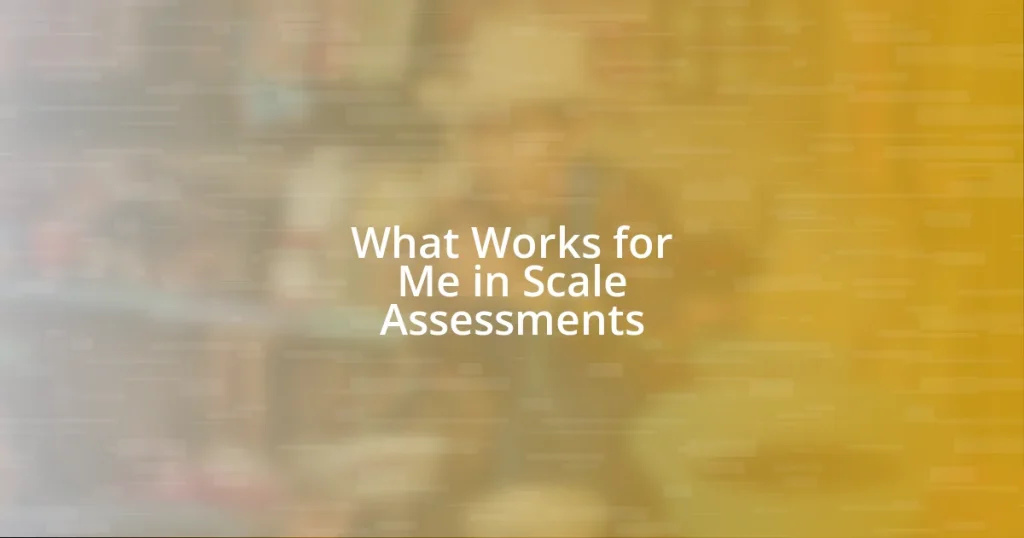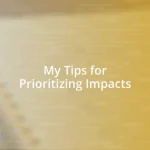Key takeaways:
- Scale assessments are essential for understanding individual progress, providing valuable insights that can foster deeper connections between educators and learners.
- Effective scale assessment tools should feature user-friendliness, customizability, real-time feedback, data-driven insights, and research-backed validity to enhance the learning experience.
- Continuous reflection and feedback, along with diversifying assessment methods, are crucial for improving student engagement and instructional strategies.

Understanding Scale Assessments Importance
Scale assessments play a crucial role in understanding individual progress and areas for improvement. I still remember the first time I received a detailed score report—it was like shedding light on my learning journey. It opened my eyes to these strengths I hadn’t recognized and areas where I truly needed to focus. Isn’t it fascinating how a simple score can shift our perspective?
Beyond mere numbers, these assessments offer valuable insights that can be transformative. When I implemented scale assessments in my own practice, I found that my students often reflected on their scores with remarkable honesty. They would ask thoughtful questions about their growth or setbacks, which guided our discussions and created a richer learning environment. Have you ever noticed how sharing these insights fosters deeper connections between educators and learners?
Emotional reactions to scale assessments can range from joy to disappointment, but I believe they should always lead to growth. I recall a student who, after initially feeling disheartened by her results, turned them into a personal challenge. Her determination was inspiring, proving to me that the real power of scale assessments lies in our ability to harness that emotional energy towards improvement. How do you respond to assessments in your learning or teaching journey—do they empower you or create barriers?

Identifying Effective Scale Assessment Tools
When searching for effective scale assessment tools, it’s essential to consider their reliability and validity. In my experience, tools that consistently produce accurate results tend to foster a greater level of trust among both educators and students. I once used a particular assessment that provided clear benchmarks, allowing me to track progress over time. It made all the difference in tailoring my teaching approach.
To identify the right scale assessment tools, look for the following characteristics:
- User-Friendly Interface: A tool that’s easy to navigate can enhance engagement.
- Customizability: The ability to tailor assessments to specific learning outcomes is critical.
- Real-Time Feedback: Instant feedback helps foster a growth mindset in learners.
- Data-Driven Insights: Tools should provide actionable insights to inform your teaching practice.
- Research-Backed Validity: Assessments supported by credible studies tend to yield more reliable results.
Each of these elements can significantly influence how effectively the assessment tool serves both educators and students. It’s all about finding what resonates and works for your unique context.

Strategies for Successful Scale Assessments
Implementing successful scale assessments requires a strategic approach. In my work, I’ve found that setting clear expectations with students before they take an assessment greatly reduces anxiety. Once, I introduced a new scale assessment and took the time to explain its purpose, reassuring students that it’s a tool for growth, not judgment. Their immediate improvement in confidence was tangible, and it fostered a more transparent environment for discussing results. How often do we underestimate the importance of framing assessments in a positive light?
Another technique I appreciate is involving students in the assessment process. This could mean allowing them to set personal goals based on prior assessments. I recall a student who expressed his desire to improve his writing skills. By letting him take charge of his learning, he became more invested in the outcome. The transformation was remarkable; I witnessed him take not just ownership of his progress, but also the journey toward achieving those goals. Isn’t it amazing how empowerment can lead to such growth?
Lastly, consistently reviewing and tweaking your assessment strategies is vital for success. After every assessment, I make it a habit to gather feedback from my students. They often offer insights that I hadn’t considered, shedding light on what worked and what didn’t. This practice doesn’t just help refine future assessments; it also shows students that their opinions matter. Do you take the time to reflect on and adjust your assessment methods, or do you find yourself sticking to a set routine?
| Strategy | Key Focus |
|---|---|
| Setting Clear Expectations | Reduces anxiety and fosters a positive perspective on assessments. |
| Student Involvement | Encourages ownership over learning and goal-setting. |
| Continuous Reflection | Incorporates student feedback for ongoing improvement of assessment strategies. |

Common Challenges in Scale Assessments
Navigating common challenges in scale assessments can often feel like a balancing act. One issue I’ve encountered is the inconsistency of student engagement. Early on, I launched an assessment that I thought would captivate my students. Instead, their lack of interest was palpable. I wondered, why would they disengage from something meant to support their learning? It made me realize that the way we present assessments can sometimes overshadow their purpose.
Another challenge is the sheer volume of data that scale assessments can generate. In one instance, I conducted an assessment that produced an array of metrics, but I struggled to distill those into actionable insights. It left me asking, how can we make vast amounts of data wearable? Learning to sift through data effectively became crucial in my practice; without that skill, the metrics risk becoming just numbers without meaning.
Finally, it’s essential to be aware of the emotional impact assessments can have on learners. I recall a student who faced significant anxiety at assessment time, fearing failure more than anything else. This experience opened my eyes; I couldn’t simply impose assessments without acknowledging their emotional weight. Haven’t we all felt that pressure? Creating a supportive environment became a priority, so students could view assessments as opportunities for growth rather than as judgment day.

Best Practices for Implementing Assessments
Implementing assessments effectively begins with communication. In my experience, I’ve learned that it’s crucial to not just explain the mechanics but also share the “why” behind each assessment. For instance, during a recent assessment rollout, I used stories from previous students who experienced growth through similar evaluations. This frame of reference helped them see this as a pathway rather than a hurdle. Can you recall a moment when understanding purpose changed your perspective?
Another best practice I value is the use of formative assessments throughout the learning process. One time, I introduced quick check-ins before a major assessment. These little moments not only gauged student understanding but also provided opportunities for real-time feedback. The shift in classroom dynamics was palpable—students felt more connected to their learning strategies, and conversations around their progress flourished. Doesn’t it feel rewarding when students take an active role in their learning journey?
Finally, it’s essential to create an atmosphere of trust and safety during assessments. I vividly remember a situation where a student, who typically shied away from sharing, bravely opened up about her struggles with anxiety during testing. This heartfelt conversation prompted me to adjust my approach, implementing calming strategies that eased pressure. By fostering such an environment, assessments transform from a source of stress into an opportunity for expression. Have you ever noticed how the right environment can completely alter the outcome of an assessment?

Analyzing Results from Scale Assessments
When it comes to analyzing results from scale assessments, I often find myself reflecting on the stories behind the numbers. For instance, I once conducted an assessment where the average scores were rather high, but I sensed something deeper—a disconnect among students who performed well. Were they truly understanding the material, or were they just good at taking tests? It pushed me to dig deeper into individual responses, helping me see the nuances that raw data can sometimes obscure.
I’ve also learned to embrace the power of collaborative analysis. After one particularly challenging assessment, I gathered a small group of colleagues to review the results together. As we discussed the various student responses and trends, insights flowed. Suddenly, patterns emerged that we hadn’t noticed before. It dawned on me: why go on this journey alone when we can learn from each other’s perspectives? Isn’t it remarkable how a single conversation can shed light on what might otherwise remain hidden?
Finally, I’ve developed a habit of connecting results back to instructional strategies. Following an assessment, I make it a point to reflect on my teaching practices. The data revealed that certain students struggled with specific concepts. This prompted me to consider how my approach might have hindered their understanding. I remember one student in particular who continuously faltered in assessments, leading me to tweak my teaching methods to better address these gaps. It reminded me that analyzing results isn’t just about the numbers; it’s about fostering growth and evolving as an educator. Have you ever had a moment where data truly changed your teaching approach?

Improving Future Scale Assessment Efforts
Improving future scale assessment efforts requires a commitment to continuous feedback. Recently, I introduced a post-assessment survey for my students, asking them what they felt worked and what didn’t. It was eye-opening! One student expressed that the timing of the assessment felt rushed, which made me rethink how I structure assessment periods. Have you ever considered how feedback from those undergoing the assessment can transform the process?
Another approach I’ve implemented is diversifying assessment methods based on student learning styles. I remember a time when I relied heavily on traditional tests, and while they served their purpose, I could see that some students were disengaged. Introducing alternative formats like presentations and group projects not only sparked enthusiasm but also allowed different strengths to shine. Isn’t it fascinating how a simple shift can rejuvenate student interest and performance?
Lastly, I’ve found that professional development is vital for educators involved in assessments. Attending workshops focusing on innovative assessment strategies has profoundly influenced my practice. For example, one memorable session on formative assessment techniques inspired me to embed mini-assessments throughout the unit. The result? Students became more self-aware of their learning processes, leading to a classroom environment buzzing with curiosity. What transformations can professional growth bring to your assessment practices?















